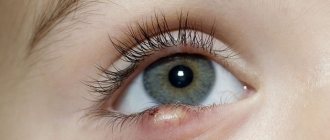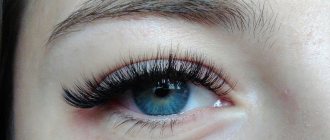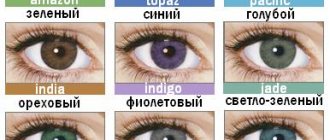Contact lenses are a convenient way to correct vision. However, unlike glasses, they require more careful attention: adherence to the regime and terms of use, daily care. If the rules for using contact optics are violated, unpleasant sensations, such as burning, may occur in the eyes. In what cases does this happen?
There may be several reasons why there may be discomfort in the eyes when wearing lenses: both the individual reaction of the organs of vision, and the user’s careless attitude to the care of optics, inappropriate cleaning products, and so on. Let's look at the details in the article.
Allergic reactions
Cases in which it is possible that the eye does not perceive the material from which the contact lens is made are extremely rare. Modern contact correction products are made from very high-quality polymers that are biocompatible with the mucous membrane of the eyes: silicone hydrogel and hydrogel. They have different parameters of oxygen permeability and moisture content, which are selected in accordance with the individual characteristics of the patient’s visual organs. Burning eyes can occur in cases where a person is susceptible to a reaction to external stimuli, for example, suffers from hay fever. During the flowering period, allergen particles accumulate on the lenses and cause discomfort. During such periods, doctors recommend using daily wear models and additionally using artificial tear drops. In many cases, the cause of discomfort is not an allergy to the lens material, but other factors.
Possible reasons
If your eyes water when in contact with lenses, the problem may be as follows:
- Optical products are chosen incorrectly: they strain the eyes, as evidenced by the appearance of tears. Most likely, we are talking about inappropriate diopters, an error in choosing the radius of curvature or diameter. It is important to know about them in order to navigate your choice.
- Allergy: the appearance of tears may indicate sensitivity of the mucous membrane to the composition of the material from which the lenses are made, or to the solution used to store them.
- Expired Expiry Date: Optical products that cause tears are likely unusable. It is important to remember that the service life is counted from the moment the blister is opened.
- Long period of use: ophthalmologists do not recommend wearing even high-quality lenses for more than 12 hours. Of course, there are optical products that are suitable for wearing for a month, but it is not recommended to overuse them to avoid the effect of dry eyes.
- Microtraumas of the shell, dryness: tears along with sharp pain accompanying putting on lenses may indicate the presence of damage. In this case, it makes sense to wash them in a special solution. Why can pain appear even after removal? This means they are still dry.
- Infection: Excessive tearing is not the only symptom. Along with it, discharge may appear, clarity and sharpness of vision are also lost, and complications appear.
Other reasons include:
- Poor quality of optical products: most likely, they do not transmit oxygen well.
- Inconsistency between the parameters of the product and the curvature of the cornea: they are not fixed simply enough, they shift, and as a result irritate the mucous membrane
- Failure to comply with hygiene rules: neglect of lens care can lead to the appearance of salt and protein deposits, which have an adverse effect on the condition of the cornea, causing it to become dry.
Infection due to poor hygiene
All lenses, except daily ones, require careful regular care, especially quarterly and traditional ones. During operation, they accumulate a lot of contaminants: protein and lipid deposits from tear fluid, dust particles, and cosmetics. Together they form plaque, which is a favorable environment for the proliferation of pathogenic microorganisms. To remove this deposit and clean the surface of the optics, special products are used:
- universal solutions for every day;
- enzymatic (enzyme) cleaners, which should be used to clean protein deposits once every 10 days;
- peroxide deep cleaning systems - once a month.
If the recommended hygiene rules are not followed, the accumulated contaminants will cause itching and irritation in the eyes, and, in addition, will provoke the development of infectious inflammatory diseases: keratitis, conjunctivitis, etc. If you violate the wearing regime and leave daytime wear models on your eyes at night, or use them without removing them for several days, similar reactions occur.
Causes of burning eyes from wearing contact lenses
Contact lenses are a vision correction method that is being chosen by more and more people because it has so many benefits. Let's name just a few of them: the lenses are not noticeable to others, do not limit freedom of movement in any way, and do not fog up.
The reasons why you may feel discomfort while wearing lenses can be different: from non-compliance with the wearing regimen and care rules to individual intolerance. Let's look at these reasons in more detail.
The occurrence of infectious eye diseases due to non-compliance with recommendations for lens care.
The fact is that all contact lenses accumulate dirt during wear: protein, dust particles, cosmetics. All this is a favorable environment for the growth of bacteria. Therefore, all types of contact lenses, except daily ones, need to be cleaned using special solutions. If you neglect to clean your lenses, this can lead to the development of infectious inflammatory eye diseases: conjunctivitis, keratitis, etc. If you violate the wearing regime, use them without removing them for several days and leave them on your eyes overnight, there is also a high risk of developing infections that cause burning in the eyes.
Allergic reactions.
Allergic reactions to the contact lens material itself are very rare, because the lenses are made from polymers that are biocompatible with the mucous membrane of the eye. Burning eyes can be caused by external irritants and allergens. For example, particles of plant pollen can accumulate on the surface of lenses and cause discomfort. In this case, it is recommended to use daily contact lenses and instill moisturizing eye drops.
Inappropriate solution composition.
Multipurpose contact lens cleaning and storage solutions may contain preservatives that cause itching and irritation in some people. In this case, contact an ophthalmologist, he will help you choose the appropriate solution.
Dry eye syndrome
This disease is becoming quite common among people of different ages. Most often it occurs after prolonged continuous work at the computer. Due to intense gaze at the monitor, we blink less often, the tear film dries out, and a rush of blood occurs to the vessels of the eyes. As a result, the organs of vision turn red and there is a feeling of dryness and burning. In addition, if a person works at a computer wearing lenses, they also dry out, which causes discomfort. To avoid this, ophthalmologists recommend using moisturizing drops. Thanks to the drops, a thin film is formed on the surface of the eyes, which provides long-lasting hydration.
The contact lens is not inserted correctly
Before putting on the lens, make sure that it is not inside out, otherwise you will not avoid unpleasant sensations. Its edges should not be curved, and it itself should resemble a plate in shape. The lens should be dome shaped. Some models of contact lenses are equipped with special marks that can be used to determine the correct position of the lenses.
Incorrect selection of lenses according to parameters
Contact lenses that do not fit your eyes can cause discomfort when worn. A lens that is too large will rub against the eyelid when blinking, and a lens that is too small will pinch the cornea, impeding normal blood supply. To prevent this from happening, you should select lenses according to a prescription from an ophthalmologist, which indicates its base curvature and diameter.
Choosing the right contact lens model and care products, as well as following all recommendations for use, will help avoid complications for eye health.
Dry eye syndrome
Dry eye syndrome, or xerophthalmia, affects many people. In recent years, this disease has especially developed due to the frequent use of gadgets and computers, with which other users spend a lot of time. In this case, severe drying of the mucous membrane occurs. Normally, a person blinks approximately 11-12 times per minute. When looking intensely at the monitor, the blinking frequency decreases by about half to 5-6 times. At the same time, the tear film dries out, the eye tends to be moistened from the inside, and a rush of blood occurs to the vessels of the conjunctiva. The organs of vision turn red, a feeling of dryness and irritation appears. At the same time, the lens can also dry out at the end of the day, as it lacks natural hydration from tear fluid. Ophthalmologists recommend that people who spend a lot of time at the computer use moisturizing eye drops. They often contain hyaluronic acid. It has the ability to bind together and hold water molecules on the surface. Products with sodium hyaluronate form a thin film on the surface of the lenses, thereby preventing their dehydration and providing long-term hydration.
Why do my eyes dry out?
A condition in which the visual organs are constantly lacking moisture is commonly called “dry eye” syndrome.
It occurs as a result of impaired production of tear secretion. For some reason, the fluid is produced in insufficient quantities or has the wrong composition. The pathology manifests itself as a complex of characteristic symptoms - dryness, burning, itching, foreign body sensation, etc. Sometimes dry eye syndrome is accompanied by a decrease in visual acuity and tearfulness.
Poor eye moisture can be associated with prolonged work at the computer, exposure to wind, dust and other negative external factors, and the use of certain medications.
Dry eye syndrome can also occur while wearing contact lenses. If there are other provoking factors, the risk of drying out the mucous membrane increases.
As a rule, lenses dry out the eyes for several reasons:
- You have chosen a model with low hydrophilicity, which does not retain moisture well;
- You wear lenses longer than recommended or do not follow the wearing regimen;
- You neglect to care for your contact lenses or do not clean your lenses thoroughly enough.
The lens is turned inside out and is not worn correctly
If your contact lenses are placed incorrectly on your eyes, you may also experience eye discomfort. Before putting them on, make sure that the lens is not turned backwards. It should look like a smooth hemisphere, and not a flat bowl with bent edges. Some models (for example, ACUVUE) have special indicator marks that help you ensure that the lens is in the correct position. For convenience, you can also use a suction stick, which makes putting it on easier, especially for those new to wearing optics.
Why can lenses hurt my eyes?
If used incorrectly, the “magic film” can pose a serious danger. After all, this is, in fact, an ordinary prosthesis, which can also get dirty, deteriorate or rub “calluses”, which is why pain appears.
Note! Colored lenses cause the most trouble. At the same time, people with poor vision treat them with care, because they know first-hand about the possible consequences. But those who have one hundred percent vision are often careless. For example, girls who choose lenses to match the color of their clothes often suffer from complications. Even a sleepless night spent in a club can cause morning eye pain. And if the night was spent wearing lenses...
“Contacts” seem to be a simple and affordable way to correct vision, but behind all this lies the most negative consequences, including loss of vision. Therefore, pain is not the worst thing . Let's try to figure out the reasons.
Incorrect selection of model according to parameters
After diagnosing the visual organs, the doctor writes a prescription with the necessary characteristics that are individually suitable for the patient’s eyes. It shows the base radius of curvature and lens diameter, as well as the power for both eyes. The prescription for toric and multifocal lenses specifies additional parameters. The model must be selected in accordance with these data. If it does not correspond to the parameters of the eyes, it will cause discomfort during use. A lens that is too large slides off the eyelid and rubs from the inside against the eyelid when blinking; a lens that is too tight pinches the cornea, impeding normal blood supply to the eye.
Reason five. Mechanical impact
This occurs when the “contacts” are selected incorrectly. For example, the fit may not be suitable or the diameter may be incorrect. All this leads to microdamage to the mucous membrane of the eye, and if worn for a long time, to perforation of the cornea and infection of the ulcers .
Eyes can hurt due to incorrect selection of lenses
Therefore, a really good ophthalmologist should be involved in the selection. Look for someone who will not only sell you devices, but will also periodically conduct examinations (often this allows you to identify the problem even before your eyes begin to hurt after the lenses).
Video: Complications when wearing contact lenses
How to avoid complications from contact lenses
To avoid unpleasant sensations in the eyes, as well as to prevent the development of inflammatory ophthalmic diseases, it is recommended to follow the basic rules of wearing contact optics.
- Handle lenses only with cleanly washed hands.
- Do not violate the wearing schedule, as well as the replacement period for products.
- Select the model strictly in accordance with the parameters specified in the recipe.
- Use additional moisturizing solutions in extreme conditions (for example, when in a dry and constantly air-conditioned room).
Proper selection of the model, compliance with all care recommendations and requirements for replacement periods will help to avoid complications for the eyes when wearing optics. You will find a large selection of contact lenses from global manufacturers, as well as additional products and accessories on the Ochkov.Net website.
Lenses dry out your eyes - what to do?
If you constantly experience discomfort and dryness while wearing lenses, it is recommended to remove them and seek advice from a specialist. First of all, the doctor will conduct an examination and collect anamnesis to determine the cause of dryness. Depending on the diagnostic results, he may give several recommendations on what to do to solve the problem.
- Use moisturizing drops.
If optical products are selected correctly, and dryness is caused by unfavorable factors (conditioned air, heavy visual load, wind, etc.), then the problem can often be solved with the help of moisturizing drops. You need to choose those products that are compatible with contact optics and can be used without removing them. For example, you can moisturize the surface of contact lenses using Optimed Drops, Adria Relax, and Artelak Splash.
- Maintain contact optics hygiene.
Often, lenses dry out the eyes because the user does not care for the optics carefully enough. In this sense, one-day models that do not need to be cleaned are considered the most comfortable and safe. If you use optical products for scheduled replacement, regular cleaning and disinfection are the key to eye comfort. To reduce the likelihood of dry eyes, cleansing can be done with multifunctional and universal solutions with hyaluronic acid (for example, Unica Sensitive or Biotrue). They not only remove dirt well and destroy pathogenic microorganisms, but also moisturize the surface of the polymer material, prevent the evaporation of liquid, and maintain the stability of the tear film.
- Follow the wearing schedule and replacement period.
If optical products require daily wear, and you do not take them off for several days in a row, then dryness and discomfort of the eyes will appear quite quickly. Similar problems arise if you continue to wear lenses after the replacement period has passed.
The appearance of discomfort when contact optics are worn out is due to several reasons. Firstly, different materials have different resistance to organic deposits and, if the replacement period is not observed, an infection can get into the eyes. Secondly, lenses for daily and extended wear differ in the level of gas permeability and other important characteristics that are responsible for hydration, nutrition and comfort of the visual organs.
If the recommended duration and mode of use are violated, the eyes lose moisture and do not receive nutrients. In addition, there is a risk of developing serious eye pathologies.
Is the problem always in the lenses?
Sometimes it's not their fault. Pain in the eyes can occur for a trivial reason - due to an eyelash or speck. In this regard, it is necessary to have a container with tweezers on hand at all times in order to quickly remove the device, clean it and insert it back.
Sometimes the cause of pain is an eyelash or a speck of dust caught in the eye
Another cause may be bacterial keratitis . During bathing, improper hygiene when removing/putting on, or using ordinary running water when caring for devices, harmful microorganisms can enter the eyes. Such an illness requires long-term treatment (in especially severe cases it takes several months).
Note! At the slightest suspicion of keratitis, you should immediately go to the hospital! The earlier the disease is detected, the less severe the consequences will be. In addition, you should not wear lenses if you have an eye infection or while taking medicine. drugs.










